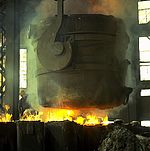 Carbon steel has become a popular material for use in the manufacturing industry. As the name suggests, it consists of steel along with a carbon alloy for enhanced properties. The American Iron and Steel Institute (AISI) defined carbon steel as being steel when “…no minimum content is specified or required for chromium, cobalt, molybdenum, nickel, niobium, titanium, tungsten, vanadium or zirconium, or any other element to be added to obtain a desired alloying effect;
Carbon steel has become a popular material for use in the manufacturing industry. As the name suggests, it consists of steel along with a carbon alloy for enhanced properties. The American Iron and Steel Institute (AISI) defined carbon steel as being steel when “…no minimum content is specified or required for chromium, cobalt, molybdenum, nickel, niobium, titanium, tungsten, vanadium or zirconium, or any other element to be added to obtain a desired alloying effect;
when the specified minimum for copper does not exceed 0.40 percent.”
But there are several different types of carbon steel, each of which has its own unique characteristics. To learn more about the different types of carbon steel and how they compare to one another, keep reading.
The most common type of carbon steel is mild or low-carbon steel. Also known as plain-carbon steel, it contains a very small percentage of carbon material, making it a cost-effective solution for consumers and business owners alike. But don’t let its low concentration of carbon fool you into thinking its sub-par. Low-carbon steel is both strong and durable, although it’s not easily tempered. In terms of specifications, it generally has around 0.05 to 0.25% carbon, meaning it’s rather malleable and ductile when compared to other materials of this nature. Low carbon steel can become harder and stronger, however, through the process of carburizing.
On the other side of the fence is higher-carbon steels, which lives up to its namesake by featuring a larger percentage of carbon content. Higher-carbon steels generally have a carbon content of between 0.30 to 1.70%. That’s a pretty substantial amount more than its low-carbon counterpart. It’s important to note, however, that the addition of impurities can dilute and degrade the quality of higher-carbon steels. When sulfur is added, for instance, it results in a red-short steel that’s more susceptible to breakage at working temperatures. A36 grade carbon steel has around 0.05% sulfur, and it’s known to melt at around 2599 to 2800 degrees Fahrenheit.
To recap, most carbon steels fall under one of two different categories: low-carbon or high-carbon. Low-carbon steel contains a lower percentage of carbon content, making it cheaper to produce but also weaker than its counterpart. High-carbon steel is more expensive to produce, albeit it’s stronger. Hopefully, this will give you a better understanding of the different carbon steels and their respective properties.
